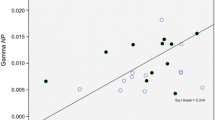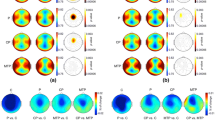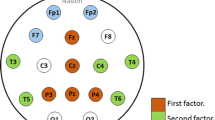Abstract
Spectral entropy (SE), also known as Shannon entropy, is a useful parameter for quantifying the global regularity of the electroencephalographic (EEG) signal. Hence, it is of interest in the assessment of the electrophysiological correlates of cognitive processing in schizophrenia. However, to date, SE has been barely used in studies comparing resting EEG recordings between patients and controls. In this work, we compared SE between resting baseline [−250 0] ms and active task [150 550] ms windows of a P300 task in 31 patients with schizophrenia and 38 controls. Moreover, we also calculated the median frequency (MF) and relative power in each frequency band for these windows to assess the correlates of the possible SE differences. Controls showed a significant (p < 0.0029) SE decrease (i.e., meaning higher signal regularity) from baseline to the active task window at parietal and central electrode sites. This SE decrease from baseline to active conditions was significantly lower in patients. In controls, this SE decrease was accompanied by a statistically significant decrease in MF (i.e., a significant slowing of the EEG activity), not observed in patients. In this latter group, the difference in SE between resting baseline and active task windows was inversely correlated to positive and total symptoms scores, as measured with the positive and negative symptoms scale. Our data support the relevance of SE in the study of cerebral processing in schizophrenia.




Similar content being viewed by others
References
Fernandez A, Gomez C, Hornero R, Lopez-Ibor JJ (2012). Complexity and schizophrenia. Prog Neuropsychopharmacol Biol Psychiatry
Shannon CE (1948) A mathematical theory of communication. Bell Syst Tech 379–423:623–656
Inouye T, Shinosaki K, Sakamoto H, Toi S, Ukai S, Iyama A et al (1991) Quantification of EEG irregularity by use of the entropy of the power spectrum. Electroencephalogr Clin Neurophysiol 79:204–210
Freeman WJ, Quiroga R (2013) Time–frequency analysis. In: Freeman WJ, Quiroga R (eds) Imaging brain function with EEG. Springer, New York, pp 37–48
von Stein A, Chiang C, Konig P (2000) Top-down processing mediated by interareal synchronization. Proc Natl Acad Sci USA 97:14748–14753
Womelsdorf T, Schoffelen JM, Oostenveld R, Singer W, Desimone R, Engel AK et al (2007) Modulation of neuronal interactions through neuronal synchronization. Science 316:1609–1612
Kopell N, Ermentrout GB, Whittington MA, Traub RD (2000) Gamma rhythms and beta rhythms have different synchronization properties. Proc Natl Acad Sci USA 97:1867–1872
Linden DE, Prvulovic D, Formisano E, Vollinger M, Zanella FE, Goebel R et al (1999) The functional neuroanatomy of target detection: an fMRI study of visual and auditory oddball tasks. Cereb Cortex 9:815–823
Polich J (2007) Updating P300: an integrative theory of P3a and P3b. Clin Neurophysiol 118:2128–2148
Doege K, Bates AT, White TP, Das D, Boks MP, Liddle PF (2009) Reduced event-related low frequency EEG activity in schizophrenia during an auditory oddball task. Psychophysiology 46:566–577
Kubicki M, McCarley R, Westin CF, Park HJ, Maier S, Kikinis R et al (2005) A review of diffusion tensor imaging studies in schizophrenia. J Psychiatr Res 41:15
Sabeti M, Katebi S, Boostani R (2009) Entropy and complexity measures for EEG signal classification of schizophrenic and control participants. Artif Intell Med 47:263–274
Schoen W, Chang JS, Lee U, Bob P, Mashour GA (2011) The temporal organization of functional brain connectivity is abnormal in schizophrenia but does not correlate with symptomatology. Conscious Cogn 20:1050–1054
Kay SR, Fiszbein A, Opler LA (1987) The positive and negative syndrome scale (PANSS) for schizophrenia. Schizophr Bull 13:261–276
Segarra N, Bernardo M, Gutiérrez F, Justicia A, Fernández-Egea E, Allas M et al (2011) Spanish validation of the brief assessment in cognition in schizophrenia (BACS) in patients with schizophrenia and healthy controls. Eur Psychiatry 26:69–79
Bledowski C, Prvulovic D, Hoechstetter K, Scherg M, Wibral M, Goebel R et al (2004) Localizing P300 generators in visual target and distractor processing: a combined event-related potential and functional magnetic resonance imaging study. J Neurosci 24:9353–9360
Keren AS, Yuval-Greenberg S, Deouell LY (2010) Saccadic spike potentials in gamma-band EEG: characterization, detection and suppression. Neuroimage 49:2248–2263
Delorme A, Makeig S (2004) EEGLAB: an open source toolbox for analysis of single-trial EEG dynamics including independent component analysis. J Neurosci Methods 134:9–21
Blanco S, García H, Quiroga R, Romanelli L, Rosso OA (1995) Stationarity of the EEG series. IEEE Eng Med Biol Mag 14:395–399
Poza J, Hornero R, Escudero J, Fernandez A, Sanchez CI (2008) Regional analysis of spontaneous MEG rhythms in patients with Alzheimer’s disease using spectral entropies. Ann Biomed Eng 36:141–152
Aviyente S, Brakel LA, Kushwaha RK, Snodgrass M, Shevrin H, Williams WJ (2004) Characterization of event related potentials using information theoretic distance measures. IEEE Trans Biomed Eng 51:737–743
Berezianos A, Tong S, Thakor N (2003) Time-dependant entropy estimation of EEG rhythm changes following brain ischemia. Ann Biomed Eng 31:221–232
Abasolo D, Hornero R, Espino P, Alvarez D, Poza J (2006) Entropy analysis of the EEG background activity in Alzheimer’s disease patients. Physiol Meas 27:241–253
Poza J, Gómez C, Bachiller A, Hornero R (2012) Spectral and non-linear analyses of spontaneous magnetoencephalographic activity in Alzheimer’s disease. J Healthc Eng 3:299–321
Roach BJ, Mathalon DH (2008) Event-related EEG time-frequency analysis: an overview of measures and an analysis of early gamma band phase locking in schizophrenia. Schizophr Bull 34:907–926
Simon R, Radmacher MD, Dobbin K, McShane LM (2003) Pitfalls in the use of DNA microarray data for diagnostic and prognostic classification. J Natl Cancer Inst 95:14–18
Gómez C, Hornero R, Abásolo D, Fernández A, Escudero J (2009) Analysis of MEG background activity in Alzheimer’s disease using nonlinear methods and ANFIS. Ann Biomed Eng 37:586–594
Hong LE, Summerfelt A, Mitchell BD, O’Donnell P, Thaker GK (2012) A shared low-frequency oscillatory rhythm abnormality in resting and sensory gating in schizophrenia. Clin Neurophysiol 123:285–292
Diez A, Suazo V, Casado P, Martin-Loeches M, Molina V (2013) Spatial distribution and cognitive correlates of gamma noise power in schizophrenia. Psychol Med 43:1175–1186
Suazo V, Diez A, Martin C, Ballesteros A, Casado P, Martin-Loeches M et al (2012) Elevated noise power in gamma band related to negative symptoms and memory deficit in schizophrenia. Prog Neuropsychopharmacol Biol Psychiatry 38:270
Winterer G, Weinberger DR (2004) Genes, dopamine and cortical signal-to-noise ratio in schizophrenia. Trends Neurosci 27:683–690
Shin YW, Krishnan G, Hetrick WP, Brenner CA, Shekhar A, Malloy FW et al (2010) Increased temporal variability of auditory event-related potentials in schizophrenia and schizotypal personality disorder. Schizophr Res 124:110–118
Buzsaki G, Draguhn A (2004) Neuronal oscillations in cortical networks. Science 304:1926–1929
Devrim M, Demiralp T, Ademoglu A, Kurt A (1999) A model for P300 generation based on responses to near-threshold visual stimuli. Brain Res Cogn Brain Res 8:37–43
Fair DA, Cohen AL, Power JD, Dosenbach NU, Church JA, Miezin FM et al (2009) Functional brain networks develop from a “local to distributed” organization. PLoS Comput Biol 5:e1000381
Supekar K, Musen M, Menon V (2009) Development of large-scale functional brain networks in children. PLoS Biol 7:e1000157
Hagmann P, Sporns O, Madan N, Cammoun L, Pienaar R, Wedeen VJ et al (2010) White matter maturation reshapes structural connectivity in the late developing human brain. Proc Natl Acad Sci USA 107:19067–19072
Kapur S (2003) Psychosis as a state of aberrant salience: a framework linking biology, phenomenology, and pharmacology in schizophrenia. Am J Psychiatry 160:13–23
Takahashi T, Cho RY, Mizuno T, Kikuchi M, Murata T, Takahashi K et al (2010) Antipsychotics reverse abnormal EEG complexity in drug-naive schizophrenia: a multiscale entropy analysis. Neuroimage 51:173–182
Jahshan C, Wynn JK, Mathis KI, Altshuler LL, Glahn DC, Green MF (2012) Cross-diagnostic comparison of duration mismatch negativity and P3a in bipolar disorder and schizophrenia. Bipolar Disord 14:239–248
Mondragon-Maya A, Solis-Vivanco R, Leon-Ortiz P, Rodriguez-Agudelo Y, Yanez-Tellez G, Bernal-Hernandez J et al (2013) Reduced P3a amplitudes in antipsychotic naive first-episode psychosis patients and individuals at clinical high-risk for psychosis. J Psychiatr Res 47:755–761
Rissling AJ, Park SH, Young JW, Rissling MB, Sugar CA, Sprock J et al (2013) Demand and modality of directed attention modulate “pre-attentive” sensory processes in schizophrenia patients and nonpsychiatric controls. Schizophr Res 146:326–335
Acknowledgments
The present work was supported in part by: Ministerio de Economía y Competitividad and FEDER under project TEC2011-22987 and by the “Project Cero 2011 on Ageing” from Fundación General CSIC, Obra Social La Caixa and CSIC; Fondo de Investigaciones Sanitarias (Instituto de Salud Carlos III) (FIS PI1102203) and the Gerencia Regional de Salud de Castilla y León (GRS 613/A/11) grants; a Marie Curie Intra European Fellowship within the 7th European Commission Framework Programme (330156-CODIP) to A. Díez; a predoctoral scholarship from the University of Salamanca and Santander Bank to V. Suazo; and a PIF-UVA grant from the University of Valladolid to A. Bachiller.
Conflict of interest
All authors have approved the final manuscript. On behalf of all authors, the corresponding author states that there is no conflict of interest.
Ethical standards
The authors assert that all procedures contributing to this work comply with the ethical standards of the relevant national and institutional committees on human experimentation and with the Helsinki Declaration of 1975, as revised in 2008.
Author information
Authors and Affiliations
Corresponding author
Electronic supplementary material
Below is the link to the electronic supplementary material.
Rights and permissions
About this article
Cite this article
Bachiller, A., Díez, A., Suazo, V. et al. Decreased spectral entropy modulation in patients with schizophrenia during a P300 task. Eur Arch Psychiatry Clin Neurosci 264, 533–543 (2014). https://doi.org/10.1007/s00406-014-0488-6
Received:
Accepted:
Published:
Issue Date:
DOI: https://doi.org/10.1007/s00406-014-0488-6




